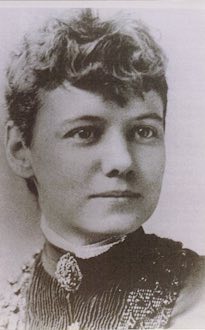Nellie Bly was born Elizabeth Jane Cochran in 1864. In the 1880s and 1890s, as a reporter for Joseph Pulitzer’s New York World, she was a pioneer in investigative reporting.
Before the “muckrakers” of the early 20th century publicized corruption and today’s investigative reporters sought the “story behind the story,” Bly was one of the first to “go behind the scenes” to expose the ills of society. At considerable personal risk, she had herself committed
to a mental institution so she could study first-hand how people with mental illnesses were treated. As a result of her ‘exposé’, the care of people with mental illnesses was reformed. The New York Journal recognized her as the “best reporter in America.”
After her husband’s death in 1905, she took over his failing industries, introduced the steel barrel to the distilling process, and made the companies a huge success. For almost ten years, she ran two multi-million dollar companies. More importantly, she recognized the value of treating her workers well. Her plants were social experiments, with physical fitness programs, health care, and libraries to teach employees how to read.
Later trapped in Europe while First World War broke out, she covered the war as a reporter again. Bly was a model of achievement for women.

